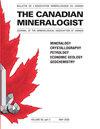石榴石端基组分相对含量的计算
IF 1.5
4区 地球科学
Q3 MINERALOGY
引用次数: 3
摘要
人们普遍认为,石榴石中端构件成分比例的计算取决于端构件数量的特定计算顺序,这一观点已被用来证明在矿物种类的定义中避免使用端构件是合理的。计算端元组分的数量以表示特定的矿物配方涉及一组联立方程的求解,因此,求解取决于端元组份数量确定顺序的想法与“联立方程”一词的含义相冲突。在这里,我检查了这些结论所基于的数据,并表明这些与序列相关的结果是由于使用了非电中性的非化学计量公式而产生的。如果稍微调整石榴石的化学式,使其完全符合石榴石的通式[8]X3[6]Y2[4]Z3O12,并且是电中性的,则将其化学式与一组端元组分相关的联立方程具有唯一的解。因此,用来证明在矿物物种的定义中避免使用端构件的论点是似是而非的。本文章由计算机程序翻译,如有差异,请以英文原文为准。
On the Calculation of the Relative Amounts of Endmember Constituents For Garnet
It is commonly accepted that the calculation of the proportions of endmember constituents in garnet is dependent on the particular sequence of calculating the amounts of the endmembers, and this belief has been used to justify avoiding the use of endmembers in the definition of a mineral species. Calculating the amounts of endmember constituents to represent a specific mineral formula involves the solution of a set of simultaneous equations, and hence the idea that the solution is dependent on the order in which the amounts of endmember constituent are determined conflicts with the meaning of the term “simultaneous equations”. Here I examine the data on which these conclusions are based and show that these sequence-dependent results arise because of the use of non-stoichiometric formulae that are not electroneutral. If a garnet formula is adjusted slightly such that it exactly fits the general formula of a garnet, [8]X3[6]Y2[4]Z3O12, and is electroneutral, the simultaneous equations relating its chemical formula to a set of endmember constituents have a single unique solution. Thus, the argument that has been used to justify avoiding the use of endmembers in the definition of a mineral species is specious.
求助全文
通过发布文献求助,成功后即可免费获取论文全文。
去求助
来源期刊

Canadian Mineralogist
地学-矿物学
CiteScore
2.20
自引率
22.20%
发文量
45
审稿时长
4-8 weeks
期刊介绍:
Since 1962, The Canadian Mineralogist has published papers dealing with all aspects of mineralogy, crystallography, petrology, economic geology, geochemistry, and applied mineralogy.
 求助内容:
求助内容: 应助结果提醒方式:
应助结果提醒方式:


